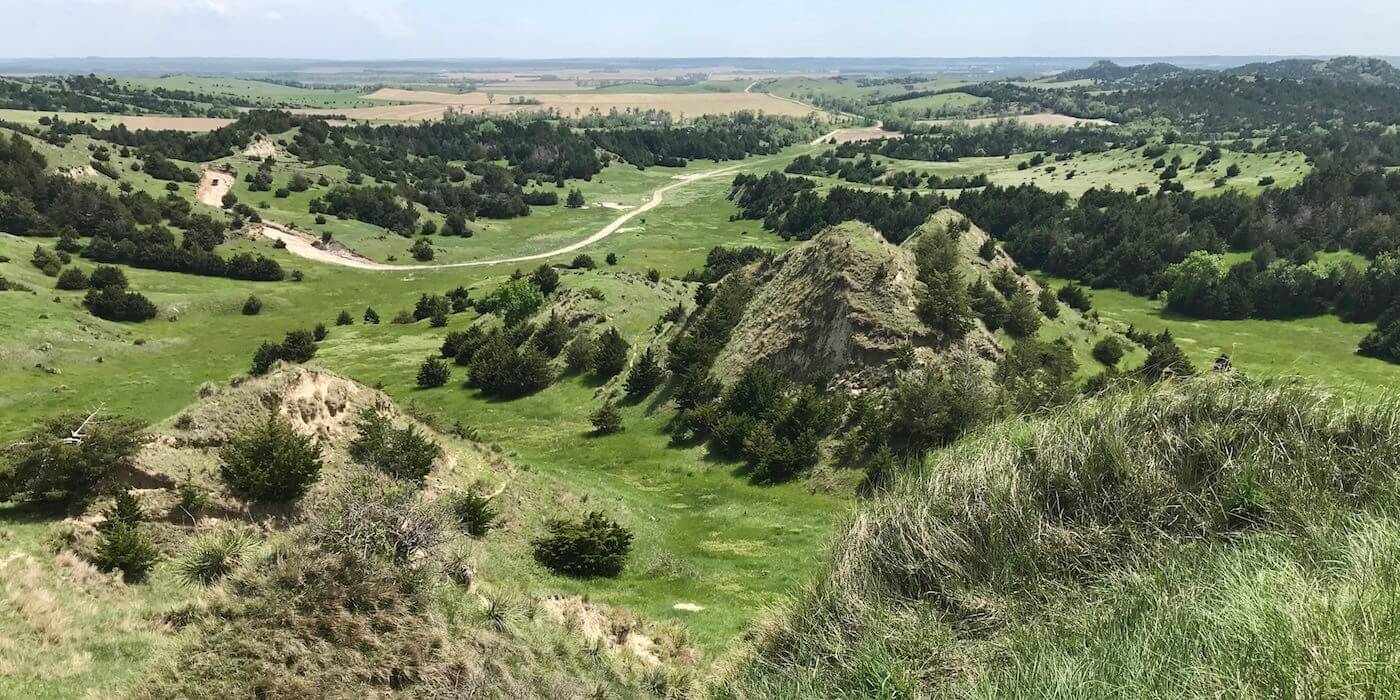Wild turkeys are one of America’s greatest conservation success stories: After being pummeled by overhunting and habitat loss more than a hundred years ago, lots of smart and dedicated conservationists, including hunters — and even Theodore Roosevelt — changed the trajectory by protecting and transplanting wild turkeys throughout America.
When I was a kid hunting in Idaho, wild turkeys were mostly an idea — they aren’t native to Idaho — but I remember hearing about a handful being released into one of our local canyons.
Fast forward to today and even Idaho has a robust turkey population with solid hunting seasons. I, however, have mostly stumbled into turkeys while hunting deer. Real spring turkey hunting in Idaho was something I always planned to do “next year.”
Enter Nebraska, Cabela’s and Bass Pro Shops
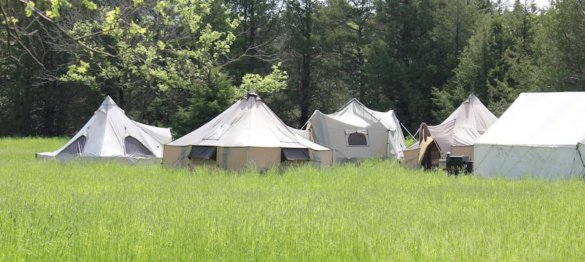
Over the years, the Cabela’s media relations team based out of the company’s Sidney headquarters has run a cool program where the company would bring several outdoor-focused journalists to Nebraska to “Turkey Camp” each spring. The journalists would get a chance to try out new turkey hunting camo, boots, hunting gear, as well as check out other Cabela’s gear like its outfitter tents, cots, sleeping bags, and more.
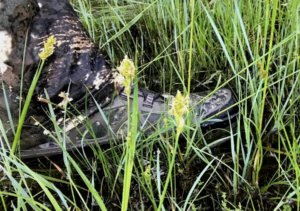
Obviously using gear in the wild is the first step toward learning whether it’s any good. In my experience, Cabela’s consistently produces great gear that’s offered at a compelling price-to-value ratio — even with its entry-level gear. I’ve been a Cabela’s fan since I was a kid pouring through mail-order catalogs in front of a roaring wood stove, so when Cabela’s offered Man Makes Fire a slot at this year’s Turkey Camp, I took all of about three seconds to consider my answer.
Of course, Bass Pro Shops acquired Cabela’s a couple of years ago and the two companies have been transitioning forward ever since as they puzzle out the business end of running two of the biggest outdoor hunting, fishing and recreation companies in the country. Consequently, at this year’s Turkey Camp we would also get a chance to check out Bass Pro Shops branded camo, gear and turkey calls, too.
Nice.
Hidden Valley Outfitters
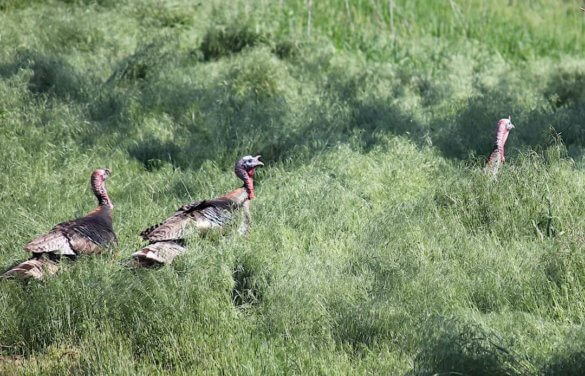
The heart of the Cabela’s Turkey Camp experience is Hidden Valley Outfitters and owner Cory Peterson. Peterson offers hunters a rural Nebraska hunting experience that spans 55,000 acres of mixed-use land. Some is farmland, CRP, livestock grazing land, along with spots of public land and rougher Nebraska sand hills sorts of terrain. In addition to turkey hunts, Hidden Valley Outfitters offers trophy mule deer and whitetail deer hunts as well as antelope, coyote and elk.
Peterson is the kind of outdoors-focused hunter, farmer and rancher whose eyes are always smiling — clearly the guy loves being outside and sharing the experience, and while he knows how to swear, he has the heart and mind of the best hunters I’ve known: He knows the land, he knows the animals and yet he marvels at not only the behavior of confounding turkeys, but at other animals, too. On one mostly open prairie and corn field hunt, he stopped me and pointed down. “Hey, there’s a sand turtle,” he said.
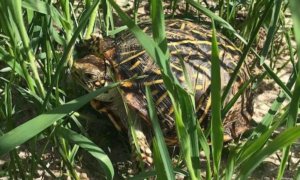
“What the heck is that?” The turtle looked like a miniature tortoise with a splash of yellow and brighter greens. “Where’s the water?”
“It’s a turtle that lives out here,” he said, gesturing at windswept fields and miles of open prairie grass. “Kids will race them at the fair. That’s a fast one.”
It turns out that a more official name is the Ornate Box Turtle, and ranchers had to start putting escape ramps into their cattle water troughs so the critters didn’t get stuck if they managed to climb into one.
Spot, Stalk and Calling Turkeys
Remember, I’m not an expert turkey hunter, I’m just a newbie sharing the experience: In late spring in Nebraska, the turkey flocks start breaking up — instead of massive flocks of dozens if not hundreds of birds, you’ll start finding a few toms with a handful of hens and jakes. While you can set up in a ground blind near roosting trees, Peterson wisely took a look at my personality and temperament and figured I might better enjoy covering a lot of ground.
“We’ll do some runnin’ and gunnin’ and see what we can tip over,” he said with a grin.
Spot on.
Long-time friend and partner Keith Metz, who also guides at Tabletop Mountain Outfitters in Wyoming, would take some of the other more experienced turkey hunters out in a variety of different setups.
As it turns out, instead of using a shotgun, I started hunting with the brand new Cabela’s Insurgent HC RTH bow. This ready-to-hunt 32.25″ axel-to-axel hunting bow slings arrows up to 330 fps but is surprisingly affordable (look for my initial review soon).
Before we arrived, the area around Arnold, Nebraska was deluged with several inches of rain. The landscape was bright green. The first morning we stumbled out of our tents before dawn, looking for Newt Borowski, our onsite Cabela’s camp leader and host, who had promised hot coffee. Good man.
Properly caffeinated, the hunters and guides started heading out. The slowly rising sun revealed a thick mist hanging over the land.
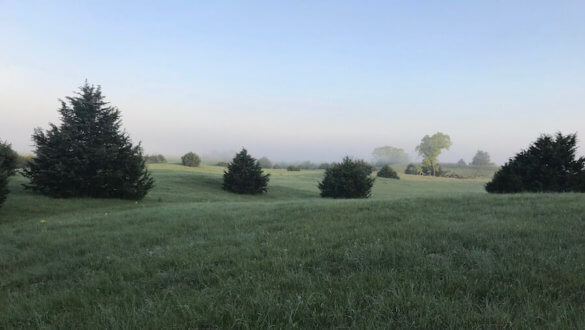
We drove down backcountry roads heading for a special spot Peterson liked to call from in a bid to locate a tom. The spot was a mix of prairie grass and a sort of fast-growing scrub cedar, the bushy eastern red cedar, which farmers planted in wind rows years ago and has since spread like giant weeds across Nebraska. The sky was silvery, the prairie grass and cedars green. All was quiet.
Peterson let out some flavor of a yelp call and a tom instantly gobbled back from several hundred yards off, hidden in the fog and cedar.
So cool.
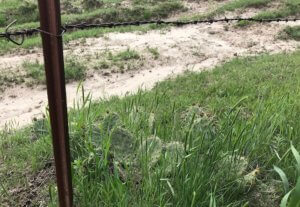
Peterson grinned. “Let’s go get him,” he whispered.
I grabbed the Insurgent HC and we slipped into the mist. Peterson called every hundred yards or so to locate the tom, and as we got closer, we set up a hen decoy and hid behind some cedar trees. Peterson called and the tom gobbled. Closer. Maybe 80 yards away, hidden in the fog. And then nothing.
Peterson called again. This time the gobble was farther off, heading away.
We circled around and came in from the other side to try again. Twenty minutes later, Peterson called and the tom gobbled from a couple hundred yards out. We repeated the process, but the tom wouldn’t come in.
“He’s probably henned up,” Peterson whispered. “Let’s close the gap.”
We snuck in closer and found the tom, his head up, slowly snaking through the grass a 100 yards out. Half a dozen mule deer does started heading toward the tom. We set up with the hen decoy and watched. The does fed past the tom, which seemed to ignore the deer. I very slowly raised a set of Cabela’s Intensity HD 10 x 42 binoculars to get a closer look. The doe was just three feet from the tom, her gray side making a backdrop in the view from the binoculars.
When Peterson called again, the tom ignored him entirely and just slipped away.
New Ground, New Turkeys
The first day of the hunt, we ended up covering a lot of ground. We would drive into a likely area and sometimes spot them from the pickup or on foot, usually from a mile or more away. Peterson could pick out a strutting tom from freakishly long distances with his naked eye — he not only knows where to look, his eyes are clearly trained to notice the tiny details that reveal birds.
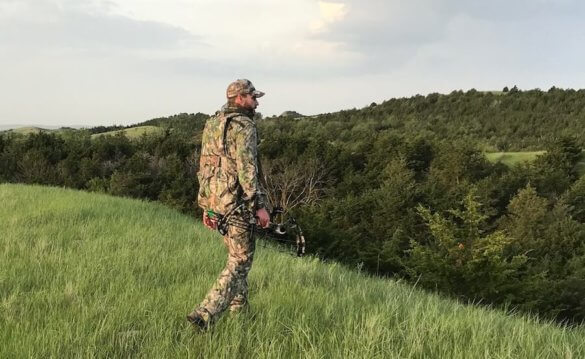
Once we spotted a likely tom, we’d figure out a way to close the distance without getting busted. We’d look for cover, use ridges to hide our movement, or drop down into draws to stay out of sight. Keen eyesight is the turkey’s super power — we didn’t worry about scent and the wind, which is a stark contrast to the elk hunting I usually do where playing the wind is always critical.
Once we maneuvered into position as close as we dared based on the terrain and cover, Peterson would set up a hen decoy, and we’d hide in grass, brush or cedars, letting the camo do its job while keeping all movement to an absolute minimum.
Peterson would yelp in a variety of ways, occasionally purring and clucking. The toms would usually gobble back and start coming in . . . but they always ended up turning and leaving. They weren’t running away, they’d just leave.
“The hens are leaving and taking the toms with them,” Peterson explained. “They don’t want any competition for their tom, and the tom’s are sticking with the hens they can see. We need to find a lone tom.”
That first day we got within shotgun distance to a couple of toms but the range and locations of brush made bow shots impossible — at least, impossible for my skill level.
Back at the Cabela’s Turkey Camp
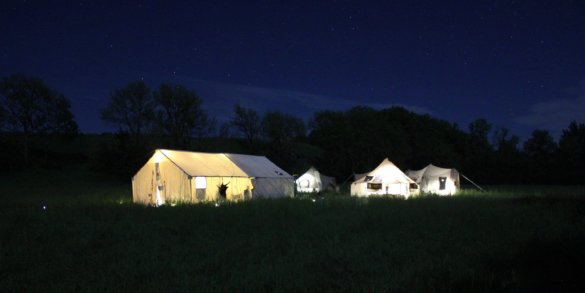
After day one, some turkeys were toppled, which was a good sign — but I’ll let the other authors on the media event tell their own stories. As they get published, I’ll link to them here.
Turkey Camp is what you’d expect if you hang out with your buddies at hunting camp. Cabela’s set up a large canvas wall tent, along with several versions of Cabela’s outfitter tents, which I’ll review, too: A couple versions have pretty impressive price-to-value ratios for hunters looking for the large-volume benefits of a wall tent but want something lighter and more affordable than a canvas wall tent.
As the hunters and guides returned from their hunts, there was lots of story telling, as you would expect — do hunters tell stories because they hunt? Or do hunters hunt because they’re story tellers? Either way, there is a camaraderie and social benefit here, no doubt deeply instilled in the DNA of hunters. There was also, of course, to my deep relief, cold beer and guys willing to play poker late into the night.
Hunt Day Two
In the first half of day two, we spotted more than a dozen toms, saw more than 100 turkeys, and stalked and called in four different sets of toms, one of which crossed 800 yards of open cattle grazing ground. As he started for our hen decoy, I started to draw back the bow but something about the decoy just wasn’t as luscious as the sound of the hen who had brought him 800 yards — he turned and started looking for her, a.k.a. Peterson, and when Peterson went silent, the tom ended up walking five feet from Peterson. The tom circled behind us in deep cedar tree cover. As Peterson worked his calls, the tom started gobbling up a storm — close, loud, insistent. Eventually he left without giving me a shot . . . surely disappointed at not finding the right hen. I started to suspect that Peterson’s calling might be too good.
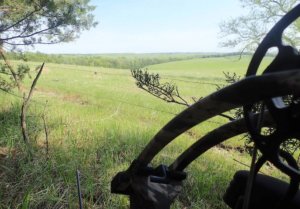
In another hunt with the bow, we had closed the distance over the top of a ridge to a group of five toms, a handful of jakes, and a dozen hens. To get close enough, we had to move in under the cover of Peterson’s tom tail fan — he held it up over his face while we moved toward the flock. I hid behind Peterson and he used the cover of brush whenever possible, slipping into the open with the fan held up like a shield before hiding back behind another small cedar tree. We got above the turkeys as they fed below us, 30 yards out. I drew back, but as the toms, jakes and hens intermingled, I couldn’t pick out a tom with a good shot. In under two seconds, they sensed something was up, which made them move around even more — I couldn’t find a bird I was confident was a tom with so many moving at once — and then they were gone.
With a shotgun, I might have been able to pick out a bird faster and even shoot it.
Finally, in one key set before lunch, we saw two toms heading up and over a ridge — perfect because they were alone without hens or jakes. We hotfooted it well around the ridge to get in front of them, then set up with a hen and Peterson went to work calling. We didn’t get in front of them but we did turn them around and they came in hot. At 60 yards out, they slowed up but kept coming, working their way closer through the prairie grass. I could see them through the branches of a cedar bush. I was well hidden in the shade, and as they hit 40 yards, I started putting tension on the bow strings, ready to draw back. A few more feet and I could draw back, still under cover, ready for them to step into the open.
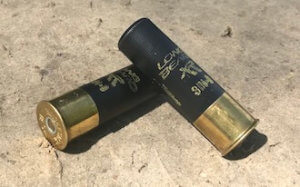
Just as they were entering that moment of cautiousness before coming the rest of the way, an old windmill a few hundred yards creaked in the wind. They turned around and left the way they came, not sprinting, but clearly they’d had enough. Was it the wind mill? Or did their super-powered eyes find something they didn’t like?
I could have shot either of the toms with a shotgun.
“Maybe it’s time I switched to a shotgun,” I said.
“Yeah,” Peterson said. “That might be better — around here most people who bow hunt do best earlier in the season.”
Back at Camp
Peterson brought me one of his personal 12 gauge shotguns and handed me a box of Winchester Long Bear XR turkey loads. “These will reach out past 60 yards,” he said. “Let’s go paper it.”
At the gun range, I blasted a paper turkey from 30 yards out a bit high on my first shot before settling into the sights correctly on my second shot. We moved back to 60 yards offhand and I shot a new paper turkey target. I was astounded at how many pellets managed to stay together at that distance.
Peterson nodded.
Day Three
Just after dawn, we arrived at a last-season corn field at the end of a road. Our previous scouting revealed that maybe the birds would fly off the roost into this field, and sure enough, this morning they were there, gobbling, yelping, and clucking up a loud cacophony of turkey chatter. From nearly a mile out, I watched through my binoculars, listening to them talk in the cool morning air. So awesome. I could see four toms strutting around in circles, but there were plenty of birds I couldn’t see.
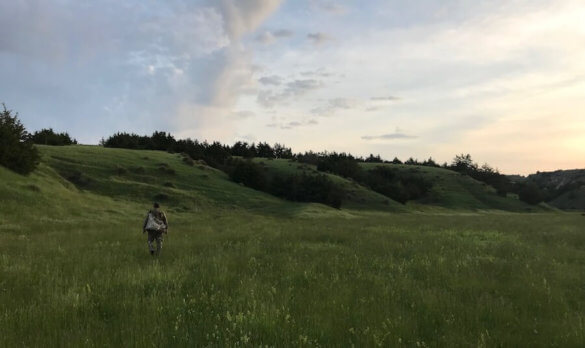
We figured they would feed up into a long draw, so we circled far around through a mess of red cedar trees, ducking, weaving and often crawling our way through. Thirty minutes later, as we neared a grassy draw, a group of jakes and toms where moving up the far ridge — not in the draw as we had expected — and just like that, we were busted.
That wasn’t the entire flock, though, so we worked our way back down toward the original field and found a more protected draw. Peterson called and a tom instantly gobbled back — a straggler from the original flock. We set up and Peterson brought him in from 500 or so yards to 200 hundred or so, but the tom wouldn’t come any closer. He’d gobble, but that was it.
“He’s hung up at the edge of the field — he won’t cross the fence line,” Peterson said.
We cut the distance in half and Peterson yelped. The tom gobbled.
We worked toward the field, hiding behind little cedar trees. I peeked out and saw him strutting in the sun, quite a ways out. Peterson took a look and, with a fierce whisper, told me to take the shot.
Boom — 52 yards and the tom dropped in the spot.
First turkey for me. He was an older bird who had broken off much of his beard somewhere along the way. The spurs were decently long, but none of that mattered to me — I’m not a trophy hunter.
“Now that’s turkey hunting!” Peterson said. “Everything can go wrong again and again and then the next day everything changes.”
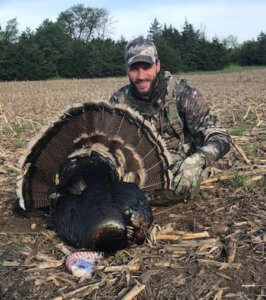
Indeed.
I learned how to pose with a turkey for the usual photos — the keys that help hunters remember and share their hunts. When I eat the turkey and see the fan, even years from now, I’ll remember this moment, stepping out, this bird, and Peterson’s grin.
As it turns out, one of Peterson’s eyes was puffed up and red. And getting puffier by the minute.
“I think something in all that brush got in my eye,” he said.
We headed back to the town of Arnold to buy some Benadryl. As his swollen eye started receding to normal, he said, “Let’s go find another bird!”
Of course, we found another tom. Peterson is a tom-finding master. We watched this tom strut in the sun for a hen, then saw him chase off three jakes before heading in the opposite direction we expected. We circled around then walked a mile up to the top of a wide grassy ridge. Found him 80 yards away in tall grass. New tactic: No calling. Odds were, any calling would send the hen scrambling and the tom would follow. So we dropped down below the ridge line and found a spot where an old grassy plateau started to drop off. We hid below the crest in the grass. Peterson pulled out a hen decoy and held it up, moving it just a bit here and there. The wind was blowing, loud enough to cover a whisper.
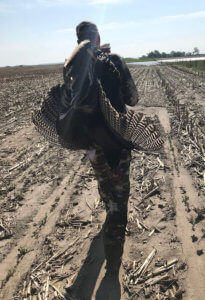
“He’s coming in — stay down,” he whispered. “OK, take a look to see where he’s at, real slow.”
I peeked through the grass. The tom was strutting his way toward us, just 30 yards out. I was ready to shoot.
“No, let him get closer,” Peterson whispered.
I ducked down to reduce the chance of being seen — I didn’t have a decoy to hide behind. Seconds ticked away like minutes. Finally, Peterson glances at me. “OK,” he whispered through a tight grin, “any closer and he’s going to tackle me!”
I rose up on my knees and found the tom sky-lined against the blue Nebraska sky. I hit him in the head from eight yards out.
And just like that — as Peterson said — different day, different result.
More Turkeys in Three Days Than . . .
I learned a lot during the Cabela’s Turkey Hunt. For starters, I saw more turkeys and turkey behavior in three days than I could have possibly seen in three years in Idaho where I hunt. The population is different, the terrain is very different, and Nebraska easily has five times the population of turkeys. If you want to see a lot of turkeys that you can hunt in a variety of different ways, Hidden Valley Outfitters can definitely connect you with some toms during Nebraska’s very long spring and fall seasons.
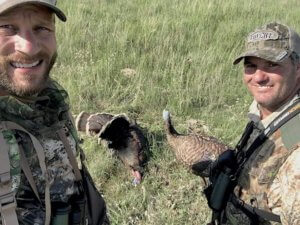
As for Cabela’s and Bass Pro Shops, like I said, I’ve been a fan of Cabela’s since I was young. I’ll be reviewing a lot of the gear I used on this trip, including some surprisingly comfortable and lightweight Bass Pro Shops camo — there is nothing better than putting gear to real-world use in varied terrain. Gotta give props to Chuck Smock, Newt Borowski, Cabela’s and Bass Pro Shops for running this program with Hidden Valley Outfitters — it’s a great way to introduce writers to a lot of new gear all at once.
One last thing: The food was fantastic, including the fresh wild turkey enchiladas — thanks, Kati! — and the company was stellar.
Truly a great experience. When the spring season opens next year in Idaho, I know what I’ll be doing.

